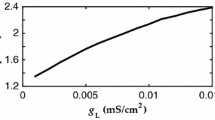Abstract
The neural basis of intersegmental coordination in animals that have been studied lies in the oscillatory output of neural networks or central pattern generators (Delcomyn, 1980). Mathematical models which describe such circuits have the potential to provide insight into neural mechanisms and design principles that operate in them. In this paper we look at intersegmental coordination in the crayfish swimmeret system, and consider two different mathematical models. In the first model, the system is represented by phase-coupled oscillators and no cellular details are present. In the second model, a simple cellular framework is formulated and preliminary results are presented.
Access this chapter
Tax calculation will be finalised at checkout
Purchases are for personal use only
Preview
Unable to display preview. Download preview PDF.
Similar content being viewed by others
References
Braun G, Mulloney B (1993) Cholinergic modulation of the swimmeret system in crayfish. J Neurophysiol 70: 2391–2398.
Braun G, Mulloney B (1995) Coordination in the crayfish swimmeret system: Differential excitation causes changes in intersegmental phase. J Neurophysiol 73: 880–885.
Delcomyn F (1980) Neural basis of rhythmic behavior in animals. Science 210: 492–498.
Kopell N, Ermentrout GB (1988) Coupled oscillators and the design of central pattern generators. Math Biosci 90: 87–109.
Mulloney B, Murchison D, Chrachri A (1993) Modular organization of pattern-generating circuits in a segmental motor system: the swimmerets of crayfish. Semin Neurosci 5: 49–57.
Paul DH, Mulloney B (1985) Local interneurons in the swimmeret system of the crayfish. J Comp Physiol A 156: 489–502.
Murchison D, Chrachri A, Mulloney B (1993) A separate local pattern-generating circuit controls the movements of each swimmeret in crayfish. J Neurophysiol 70: 2620–2631.
Skinner FK, Kopell N, Mulloney B (1997) How does the crayfish swimmeret system work? Insights from nearest neighbor coupled oscillator models. J Comput Neurosci (In Press).
Stein PSG (1971) Intersegmental coordination of swimmeret motor neuron activity in crayfish. J Neurophysiol 34: 310–318.
Author information
Authors and Affiliations
Editor information
Editors and Affiliations
Rights and permissions
Copyright information
© 1997 Springer Science+Business Media New York
About this chapter
Cite this chapter
Skinner, F.K., Kopell, N., Mulloney, B. (1997). Mathematical Models of the Crayfish Swimmeret System. In: Bower, J.M. (eds) Computational Neuroscience. Springer, Boston, MA. https://doi.org/10.1007/978-1-4757-9800-5_130
Download citation
DOI: https://doi.org/10.1007/978-1-4757-9800-5_130
Publisher Name: Springer, Boston, MA
Print ISBN: 978-1-4757-9802-9
Online ISBN: 978-1-4757-9800-5
eBook Packages: Springer Book Archive




